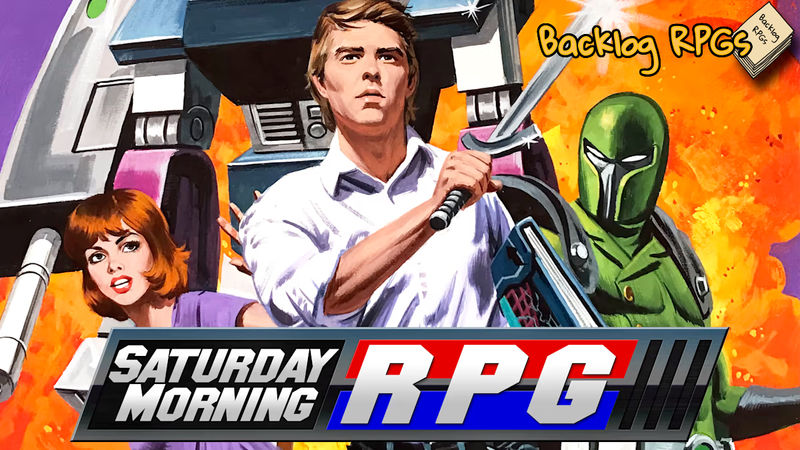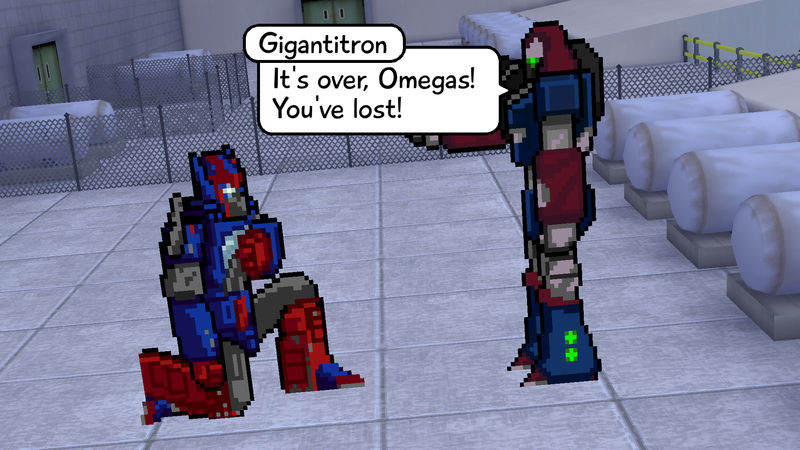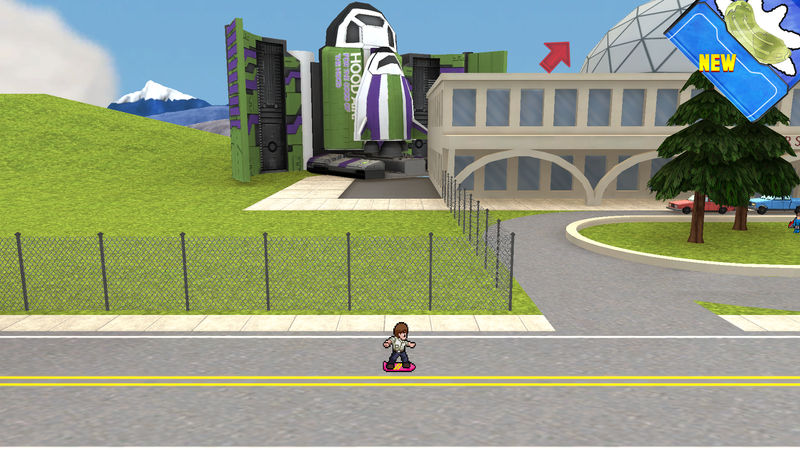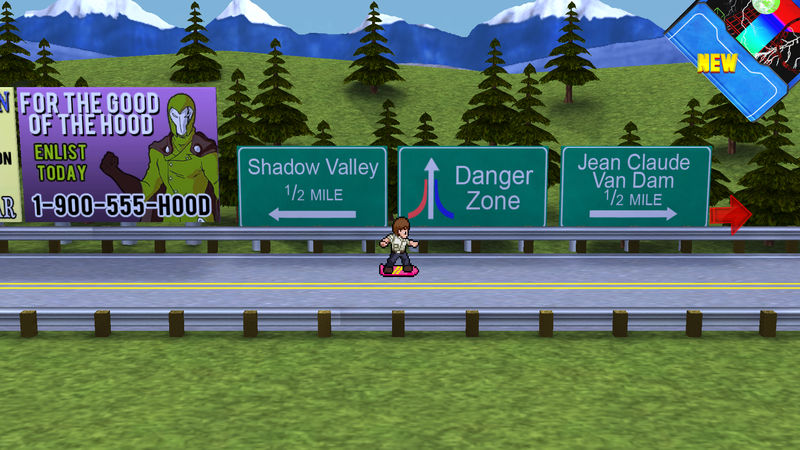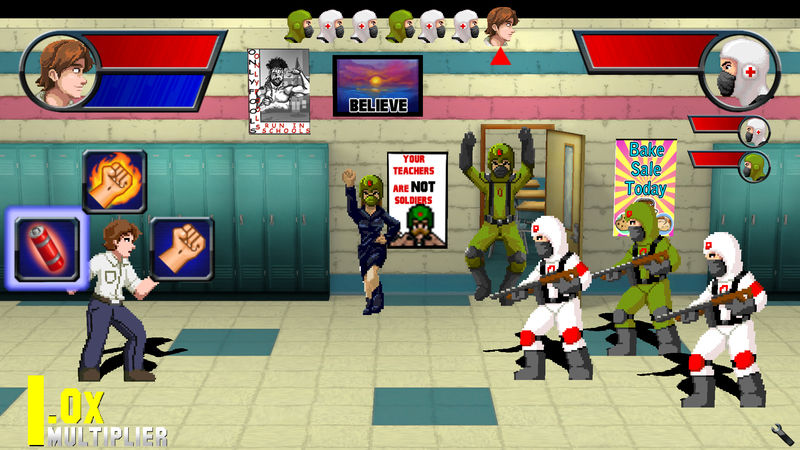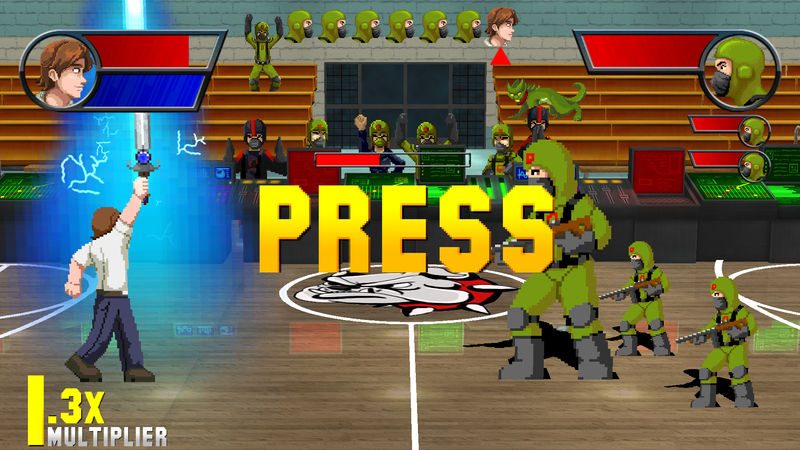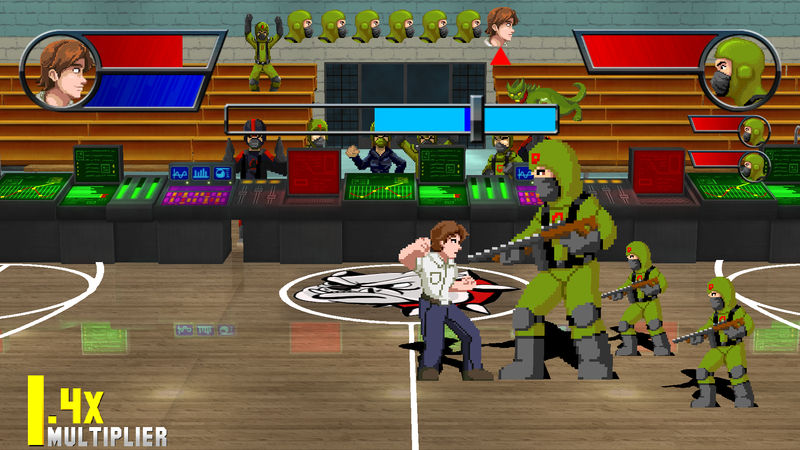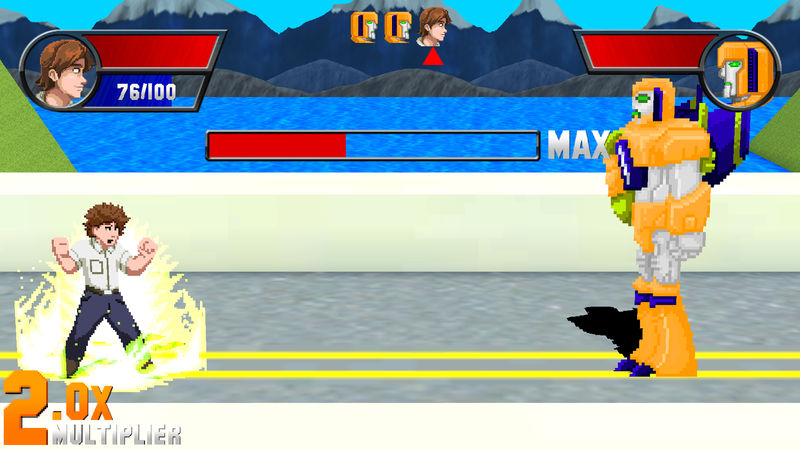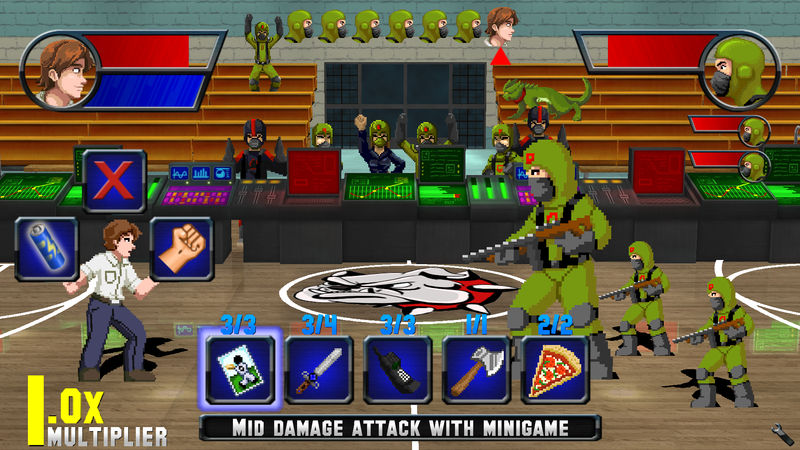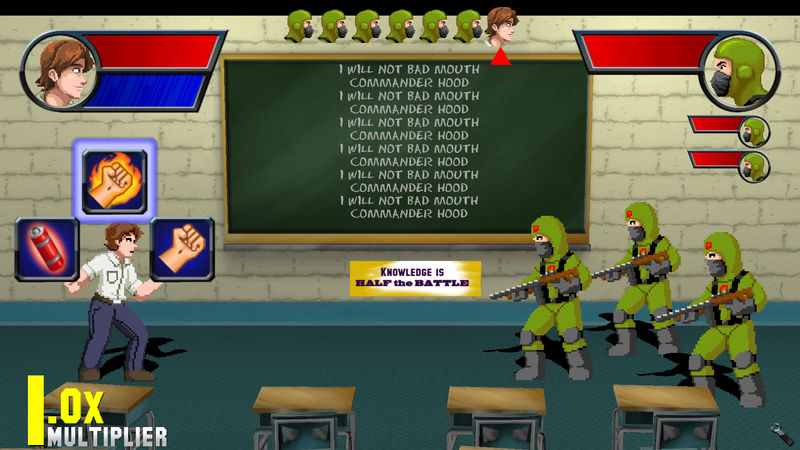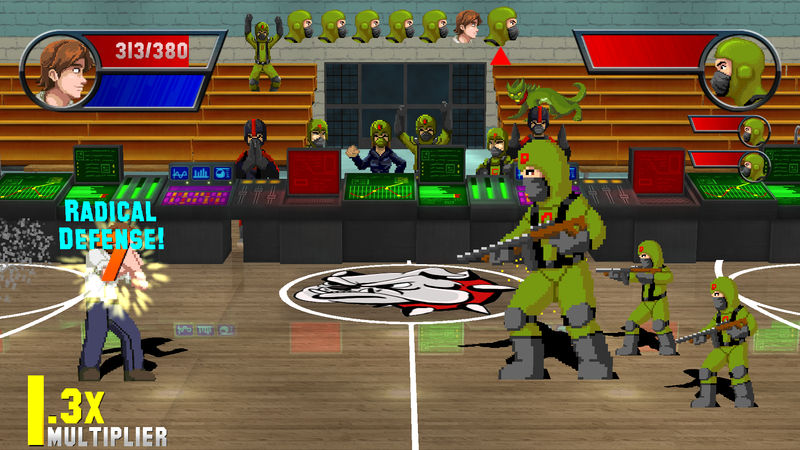Originally released for IOS in April 2012, Saturday Morning RPG was developed by Mighty Rabbit Studios, a studio that doesn’t have many famous titles on their catalogue and is mostly known for their division Limited Run Games, specialized in releasing physical editions of digital games.
On March 2013 the game was released on Android systems, and in September it became available for PCs, Macs, and Linuxes (Linuxen?). It was also a launch title for the Ouya at the same year. In 2016 PlayStation Vita and PlayStation 4 owners finally were able to purchase it and, more recently, got a physical and digital release for the Nintendo Switch, in April 2018. I played this one on PC, but there is no significant differences between them.
Saturday Morning RPG is a curious game that relies heavily on eighties and early nineties nostalgia, especially for Saturday Morning cartoon shows that were common at the time. It features the story of Marty, a high school boy who one day receives magical powers in a dream and starts to fight the recurrent villain of the week, Captain Hood and its minions. Aside the thematic novelty, the game tries to spice up the traditional turn-based battle system, with some mixed results. Should you tune in or switch over to a better broadcast? Let’s find out.
The Narrative
Similar to old cartoons, the game is divided in five different episodes with their own, self-contained, lighthearted story that uses the “monster of the week” pattern, in which the main character must thwart the villains’ plans. You will mostly fight the HOOD and its boss, Commander Hood, but some chapters expand the bad guy roster a bit.
Our tale starts within a dream of Marty, our protagonist. A common high school boy, he can’t stop Commander Hood and its minions from kidnaping his crush. But as everything seems lost, a wizard gives Marty a magical notebook that will help him in defeating the villains. After battling foes throughout the chapter and saving the girl, Marty is rewarded with waking up for another day at school.
The next chapters will take Marty across the town of Shadow Valley, a place populated by zany characters like a stalker girl, some mafiosi singing robots, a bounty hunter, intelligent bears, sentient rocks and hood soldiers that work undercover as teachers. You will visit the city’s school, its dam and space port, as well as Antarctica and a space station. There is even a Christmas Special, a fun and well-thought addition.
It’s not an exaggeration to say that the game is shrouded in nostalgia, as you will find references to eighties and early nineties properties everywhere, from dialogues, characters and on their appearance. Some made me genuinely smile, but sometimes references are made only for the sake of making references, forgetting to do anything funny or clever with them. The first chapter is the biggest culprit, and that’s why it’s my least favorite. On the next chapters, the writing comes into its own and the game becomes more than just a collection of pop culture references from a few decades ago, as the balance of humor and pure nostalgia improves. I especially enjoyed chapter two, while chapters three, four, and five were very fun to complete.
Besides defeating the episode’s villain, the game has many optional side quests that can be completed for better items and more experience. Some will put you in direct contact with Shadow Valley’s peculiar inhabitants, guaranteeing some extra giggles as you meet some odd types. Some of these situations can be solved in more than one way and will carry your choices for the next chapters.
Unfortunately, if you think that after ten years you will play the complete series, I have some bad news: episode five ends in a sort of cliffhanger. After a climactic final battle, the game makes you run for your life while the song “No risk no glory” plays on the background. It’s a great moment and you feel pumped up and ready for the final confrontation against your arch enemy, but nothing comes of it, and you’re left with a feeling of emptiness. We need closure in our lives, so please, release chapter six Mighty Rabbit Studios!
Presentation
The visuals are very simple, as you would expect from a game originally released on mobile devices. I don’t hold it against the game, as I find the graphics a bit charming with their nostalgic cues and use of simple 3D assets for its maps and objects, while characters are represented by 2D, super deformed pixel art.
Battles use a style reminiscent of comic books for the characters’ sprites, what’s more fitting than using the SD style common in old SquareSoft games. Another interesting aspect is that whenever you fight on the most urban areas there will be a fully animated crowd cheering, similar to old fighting games from Capcom and SNK. That’s a good example of evoking a nostalgic feeling gamers without relying too much on specific references.
The soundtrack was composed by Kenny Meriedeth and Vince DiCola, the latter is well known on the Transformers community for his work on The Transformers: The Movie (1986). Both composers worked together in three other titles: Angry Birds Transformers; Transformers: Devastation; Teenage Mutant Ninja Turtles: Mutants in Manhattan.
It’s a good soundtrack, but I couldn’t find any track that stuck with me, except for the aforementioned song, “No risk no glory”. It’s the type of soundtrack it’s nice to listen while playing, yet not without the game’s interactivity and visual cues. If you liked it more than I, buy it here.
Mechanics
Besides playing through each chapter multiple times, you from the main menu it’s possible to engage in endless waves of enemies and mark your presence in an online rank, or fight exclusive battles in the arena. The experience you receive will carry on to your normal play. Otherwise, the game plays like any standard RPG, where you navigate the map and fight battles in a different screen. You can explore Shadow Valley on foot or using Marty’s hoverboard.
You can play using the keyboard or, if you prefer, a PlayStation or Xbox controller. Unfortunately, if you selected a controller layout it will be switched back to a keyboard layout. This is a very annoying bug that the developers never addressed, but there is a fix here.
But let’s talk about how you kill your enemies in this game, as I have mixed feelings towards it.
The Battle System
Some games want more interactivity from their battle systems but don’t wish to completely ditch the turn-based model in favor of an action-oriented one. Saturday Morning RPG belongs to this family, as it demands little button prompts and solving other types of QTEs to perform most of the combat moves. Failing them equates to delivering less damage or totally missing an attack. This gimmick feels unnecessary as it doesn’t alter the gameplay in any meaningful way, only adding an extra step between you and your desired action. If these prompts were optative and less intrusive, providing you with special effects or more damage, I wouldn’t mind them much, but making them mandatory to hit your target only makes combat more padded.
Fortunately, the game ditches the random battles model, instead giving you a limited number of enemies to kill every chapter. But don’t worry about being underleved, as the game has plenty of fights to keep your character strong enough. If you feel you need some leveling, it’s possible to go the start screen and play the aforementioned endless enemy waves or arena battles to acquire experience.
Every battle starts with a minigame in which you must scratch off five stickers. These items are found throughout the game and, besides acting like collectibles, they have special effects like increasing Marty’s attributes, weakening enemies, granting immunity to status effects, etc. As some of these attacks require more time and effort to activate, it’s necessary to strike a balance between their usefulness and their difficulty.
When the actual combat begins you will only control Marty, as he is the game’s solo player character. There are three available actions: a common attack, special attacks, and batteries. The punch is your standard attack. It requires the completion of a minigame to land. Besides dealing some fine damage, it also recharges your magic meter. The Battery will power up your next attack in exchange of some magic, and by continuously increasing it you can deliver one hit kills even to bosses. It’s a good example of a mechanic that affects combat in a relevant manner, making your fights more strategical, contrary to the gimmick minigames.
Finally, you have Special Attacks. Unlike most games, they are not obtained by leveling up or by learning new moves with NPCs, but by acquiring different items. You can get them for free, as they lay around the scenery, or buy them from vending machines. Some deliver multiple hits, are used for healing, for causing status effects, etc. Thankfully, the game gives you detailed information about them, instead of forcing you to test each one blindly. You can choose up to five to use per battle.
Lastly, there’s a defense mechanic that’s very helpful. By pressing a button at the right time, you can lower the damage from the enemy. The closer you are to the hit, the better the results will be. It may appear contradictory, since I hated the button prompts for attacking, but in this case they are not mandatory and feel very organic to the gameplay, as the fight doesn’t come to a halt just to show you a button to press.
Ultimately, the combat system has some good ideas, like the possibility to power up your moves and timing enemy attacks to increasing your defense, but I think it misses the point with the gimmicky button prompts, as they don’t make the battles more fun and only add bloat to it. In the end I grew accustomed and stopped caring, but I won’t lie that combat would’ve been a lot better without this gimmick.
Final Thoughts
Saturday Morning RPG is a game that starts as an index of references and nostalgia, but ends up finding its own voice. Its episodic nature makes it perfect to play in small doses, however as the game clocks around seven or eight hours, you can spend your Saturday morning and afternoon to beat it. I think it’s a title worth the time, yet some people may not like it for its lighthearted and inconsequential plot.
In the last chapters the game’s side quests devolve into collect-a-thons, but I still did them to read some comical dialogues. As for the combat system, it is somewhat annoying with all the mandatory button prompts, but it has some neat ideas and a good flow. Since there is no random battles and usually dead enemies stay dead, the gimmicks will take some time to become a burden.
Final opinion: Recommended if you have nostalgia for the time the game references or want a quick and fun RPG to beat.

